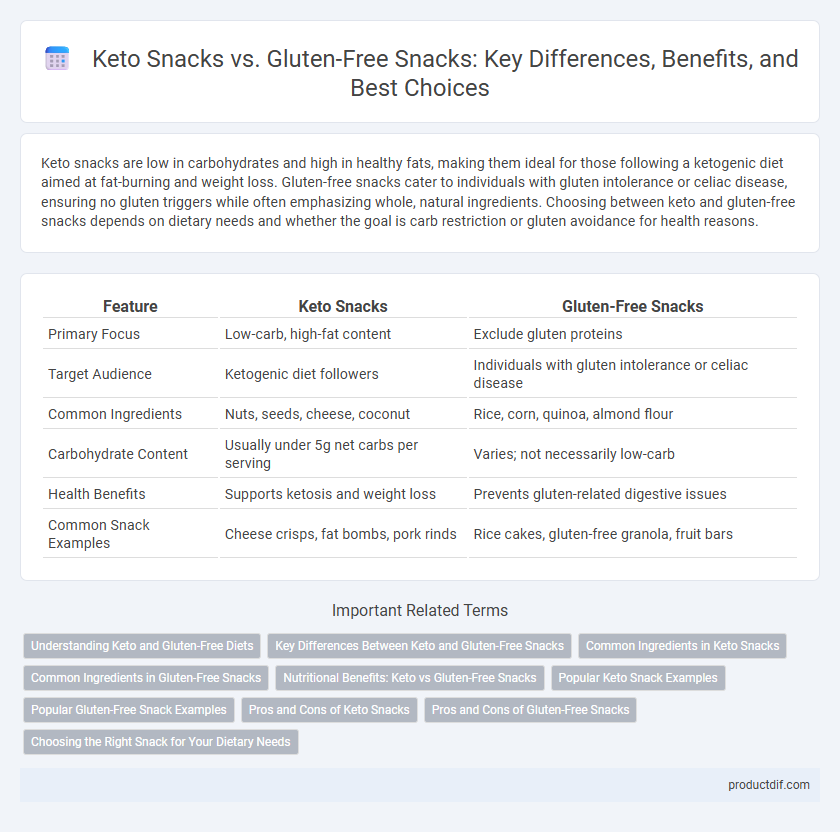Keto snacks are low in carbohydrates and high in healthy fats, making them ideal for those following a ketogenic diet aimed at fat-burning and weight loss. Gluten-free snacks cater to individuals with gluten intolerance or celiac disease, ensuring no gluten triggers while often emphasizing whole, natural ingredients. Choosing between keto and gluten-free snacks depends on dietary needs and whether the goal is carb restriction or gluten avoidance for health reasons.
Table of Comparison
| Feature | Keto Snacks | Gluten-Free Snacks |
|---|---|---|
| Primary Focus | Low-carb, high-fat content | Exclude gluten proteins |
| Target Audience | Ketogenic diet followers | Individuals with gluten intolerance or celiac disease |
| Common Ingredients | Nuts, seeds, cheese, coconut | Rice, corn, quinoa, almond flour |
| Carbohydrate Content | Usually under 5g net carbs per serving | Varies; not necessarily low-carb |
| Health Benefits | Supports ketosis and weight loss | Prevents gluten-related digestive issues |
| Common Snack Examples | Cheese crisps, fat bombs, pork rinds | Rice cakes, gluten-free granola, fruit bars |
Understanding Keto and Gluten-Free Diets
Keto snacks primarily support a low-carbohydrate, high-fat diet designed to promote ketosis, enhancing fat burning for energy. Gluten-free snacks cater to individuals with gluten intolerance or celiac disease, eliminating wheat, barley, and rye to prevent adverse reactions. Understanding these dietary needs helps in selecting snacks that align with specific health goals and dietary restrictions.
Key Differences Between Keto and Gluten-Free Snacks
Keto snacks primarily focus on low carbohydrate and high fat content to maintain ketosis, while gluten-free snacks eliminate gluten to cater to individuals with celiac disease or gluten sensitivity. Keto options often include nuts, cheese, and avocado-based products, whereas gluten-free snacks rely on alternative flours like almond, coconut, or rice flour. The nutrient profile and dietary purpose distinguish keto snacks from gluten-free options, addressing metabolic goals versus allergen avoidance.
Common Ingredients in Keto Snacks
Keto snacks commonly contain high-fat, low-carb ingredients such as almond flour, coconut flour, cheese, nuts, and seeds, which help maintain ketosis. These snacks often include natural sweeteners like stevia or erythritol to replace sugar without raising blood glucose levels. In contrast, gluten-free snacks prioritize the exclusion of gluten-containing grains but may contain higher carbohydrates, making keto-friendly ingredients more specific to low-carb content.
Common Ingredients in Gluten-Free Snacks
Common ingredients in gluten-free snacks often include rice flour, almond flour, tapioca starch, and potato starch, which provide texture and structure without gluten. Natural binders such as xanthan gum and guar gum are frequently used to mimic the elasticity that gluten offers. Ingredients like nuts, seeds, and dried fruits are also popular for their nutritional value and flavor, distinguishing gluten-free snacks from keto options that typically emphasize low-carb, high-fat components.
Nutritional Benefits: Keto vs Gluten-Free Snacks
Keto snacks typically offer high-fat, moderate-protein, and very low-carbohydrate content, supporting ketosis and sustained energy levels, which is beneficial for weight management and blood sugar control. Gluten-free snacks eliminate gluten-containing grains, reducing inflammation and digestive issues for those with celiac disease or gluten sensitivity but may contain higher carbohydrates and lower fiber. Choosing keto snacks optimizes fat metabolism and satiety, while gluten-free options prioritize digestive health and are essential for individuals with gluten intolerance.
Popular Keto Snack Examples
Popular keto snacks include almond butter, cheese crisps, and beef jerky, which are high in healthy fats and low in carbohydrates. These snacks support ketosis by minimizing carb intake, contrasting with gluten-free snacks that primarily eliminate gluten but often contain higher carbs. Keto-friendly options prioritize protein and fat content, making them ideal for those following a ketogenic diet focused on fat-burning and blood sugar control.
Popular Gluten-Free Snack Examples
Popular gluten-free snacks include rice cakes, popcorn, and fruit-based options like dried mango or apple chips, which are naturally free from gluten-containing grains. Nut mixes, yogurt-covered raisins, and gluten-free granola bars also provide convenient, tasty choices for those avoiding gluten. These snacks cater to celiac disease patients and gluten-sensitive individuals while offering diverse flavors and nutritional benefits.
Pros and Cons of Keto Snacks
Keto snacks are high in healthy fats and low in carbohydrates, making them ideal for promoting ketosis and supporting weight loss. However, they can be calorie-dense and may lack essential fibers and nutrients found in whole foods. Gluten-free snacks benefit those with gluten intolerance or celiac disease but often contain higher carbs and sugars compared to keto options.
Pros and Cons of Gluten-Free Snacks
Gluten-free snacks benefit individuals with celiac disease or gluten intolerance by preventing adverse reactions and promoting digestive health, but they can sometimes lack essential nutrients and be higher in sugar and calories compared to traditional snacks. The limited variety of whole-grain options in gluten-free snacks may reduce fiber intake, potentially impacting overall gut health. While convenient for gluten-sensitive consumers, gluten-free snacks often carry a higher price tag and may contain additives to improve texture and flavor.
Choosing the Right Snack for Your Dietary Needs
Keto snacks prioritize low-carb, high-fat ingredients such as nuts, cheese, and avocado to support ketosis, making them ideal for weight management and blood sugar control. Gluten-free snacks eliminate gluten-containing grains like wheat, barley, and rye, benefiting individuals with celiac disease or gluten sensitivity. Selecting the right snack depends on whether your primary goal is maintaining ketosis or avoiding gluten-related digestive issues.
Keto Snacks vs Gluten-Free Snacks Infographic

 productdif.com
productdif.com